Latest Environment and health reports
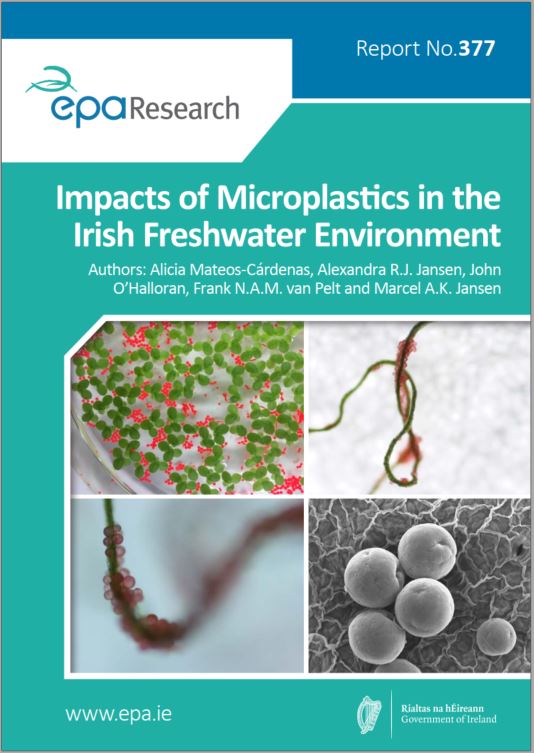
Research 377: Impacts of Microplastics in the Irish Freshwater Environment
Authors: Alicia Mateos-Cárdenas, Alexandra R.J. Jansen, John O’Halloran, Frank N.A.M. van Pelt and Marcel A.K. Jansen, June 2021
Year: 2021
Plastics are a key part of modern life, due to their desirable characteristics such as light weight and low cost. However, the extensive production of plastics is resulting in plastic pollution. This study recognises the risk posed by rapid formation of micro- and nanoplastics in the freshwater environment and advocates the rapid development of field-monitoring and impact studies to analyse hazards and risks posed by these plastics.
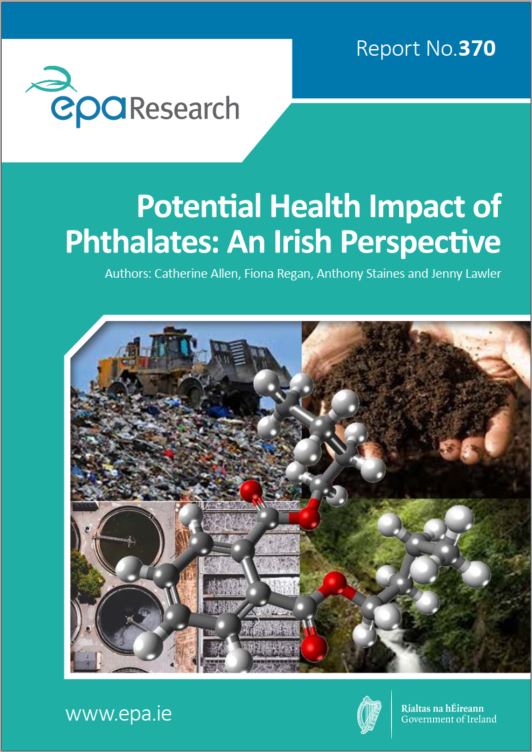
Research 370: Potential Health Impact of Phthalates: An Irish Perspective
Authors: Catherine Allen, Fiona Regan, Anthony Staines and Jenny Lawler, April 2021
Year: 2021
Phthalates are plasticisers that are ubiquitous in the environment, have the potential to disrupt the endocrine system and are associated with a wide range of adverse health effects. This report identifies that all 11 phthalates studied are currently present in the Irish environment. The levels of human exposure indicate that there is no immediate risk to human health on a population-averaged basis.
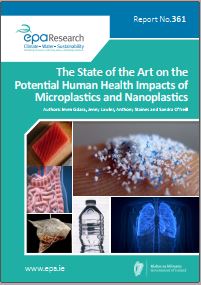
Research 361: The State of the Art on the Potential Human Health Impacts of Microplastics and Nanoplastics
Authors: Imen Gdara, Jenny Lawler, Anthony Staines and Sandra O’Neill , January 2021
Year: 2021
Human exposure to microplastics and nanoplastics through inhalation, ingestion and dermal exposure is an emerging health concern. Designing studies to assess the health effects of these exposures is challenging. Until these studies are conducted, governments should revise directives and policies on food, water and air to include MPs/NPs, to remove the potential for plastic to contaminate the food chain and our environment.
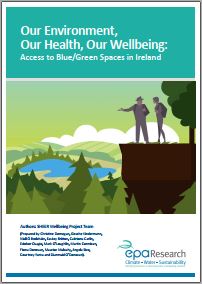
Our Environment, Our Health, Our Wellbeing: Access to Blue/Green Spaces in Ireland
Authors: SHEER Wellbeing Project Team: Christine Domegan, Gesche Kindermann, Niall Ó Brolcháin, Easkey Britton, Caitriona Carlin, Edobor Osagie, Mark O’Loughlin, Martin Cormican, Fiona Donovan, Maurice Mulcahy, Angela Sice, Courtney Yanta and Diarmuid O’Donovan, January 2021
Year: 2021
This study aimed to explore the key forces and patterns at work in relation to access to blue/green spaces in Ireland and possible impacts in national, regional and local contexts through data analytics, visualisation and mapping.
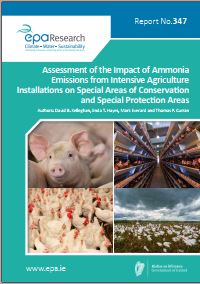
Research 347: Assessment of the Impact of Ammonia Emissions from Intensive Agriculture Installations on Special Areas of Conservation and Special Protection Are
Authors: David B. Kelleghan, Enda T. Hayes, Mark Everard and Thomas P. Curran, December 2020
Year: 2020
Atmospheric ammonia poses a significant threat to biodiversity and human health. Concentrations of ammonia in the air downwind of hotspot sources, such as pig and poultry farms, are likely to negatively affect the environment. This project quantified and assessed the impact of ammonia emissions from intensive pig and poultry units in Ireland by monitoring detailed ammonia emissions from 17 animal production houses across four farms.
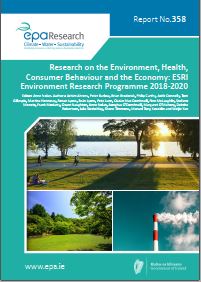
Research 358: Research on the Environment, Health, Consumer Behaviour and the Economy: ESRI Environment Research Programme 2018–2020
Authors: Achim Ahrens, Peter Barlow, Brian Broderick, Philip Carthy, Aoife Donnelly, Tom Gillespie, Martina Hennessy, Ronan Lyons, Seán Lyons, Pete Lunn, Ciarán Mac Domhnaill, Finn McLaughlin, Stefano Meneto, Frank Moriarty, Owen Naughton, Anne Nolan, Aonghus O´Domhnaill, Margaret O’Mahony, Deirdre Robertson, Iulia Siedschlag, Shane Timmons, Manuel Tong Koecklin and Weijie Yan. Editor: Anne Nolan, November 2020
Year: 2020
The EPA/ESRI Environment Research Programme brings together a diverse set of research topics with the objective of assessing the ways in which the environment interacts with economic and social processes. This report provides a detailed summary of the 12 topics examined in the second phase of the programme, which was carried out between 2018 and 2020.
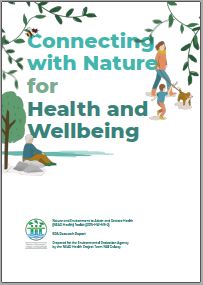
Research 348 Toolkit: Connecting with Nature for Health and Wellbeing
Authors: Caitríona Carlin, Gesche Kindermann, Easkey Britton, Martin Cormican, Christine Domegan, Mike Gormally and Diarmuid O’Donovan, October 2020
Year: 2020
This toolkit accompanies EPA Research Report 348: Nature and Environment to Attain and Restore Health (NEAR Health)
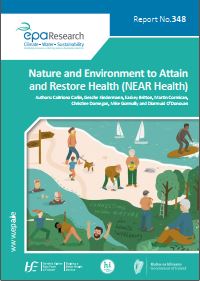
Research 348: Nature and Environment to Attain and Restore Health (NEAR Health)
Authors: Caitríona Carlin, Gesche Kindermann, Easkey Britton, Martin Cormican, Christine Domegan, Mike Gormally and Diarmuid O’Donovan, October 2020
Year: 2020
The NEAR Health project was jointly funded by the EPA and the HSE to investigate how nature and environment can help society attain and restore health. It investigated (1) how people value and experience nature, health and wellbeing, (2) the barriers and bridges to connecting with nature, (3) what people want from their healthy future environment and (4) nature-based activities that benefit people’s health and wellbeing.
Protecting and developing Ireland’s green and blue spaces to benefit our health and wellbeing
Year: 2020
Human health protection is a fundamental aspect of environmental protection. Our health is impacted by the air we breathe, the water we drink, the noise levels we experience, the food we eat, the spaces we spend time in, and our sense of wellbeing. This Brochure provides an overview and key findings of the three research projects jointly funded by the EPA and the HSE.
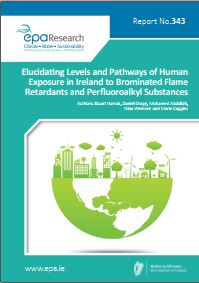
Research 343: Elucidating Levels and Pathways of Human Exposure in Ireland to Brominated Flame Retardants and Perfluoroalkyl Substances
Authors: Stuart Harrad, Daniel Drage, Mohamed Abdallah, Nina Wemken and Marie Coggins, September 2020
Year: 2020
Brominated flame retardants (BFRs) and perfluoroalkyl substances (PFASs) have been used extensively in applications such as electrical goods, soft furnishings and building insulation foam. The ELEVATE project generated data to facilitate the assessment of human exposure to these chemicals.
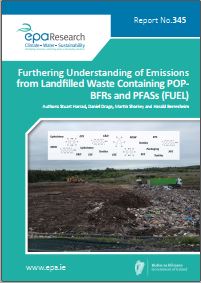
Research 345: Furthering Understanding of Emissions from Landfilled Waste Containing POPBFRs and PFASs (FUEL)
Authors: Stuart Harrad, Daniel Drage, Martin Sharkey and Harald Berresheim, September 2020
Year: 2020
Brominated flame retardants (BFRs) and perfluoroalkyl substances (PFASs) have been used extensively in applications such as electrical goods, soft furnishings and building insulation foam. The FUEL project measured these chemicals in leachate from landfills, and collected air, soil and groundwater samples traceable to these landfills to further investigate.
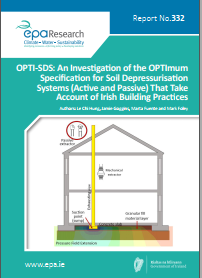
Research 332: An Investigation of the Optimum Specification for Soil Depressurisation Systems (Active and Passive) That Take Account of Irish Building Practices
Authors: Le Chi Hung, Jamie Goggins, Marta Fuente and Mark Foley, July 2020
Year: 2020
In Ireland, Radon is the second biggest cause of lung cancer and it is estimated that 9% of homes exceed the reference level of Radon. Studies in other countries have indicated that the effectiveness of passive sumps is enhanced by sealing across the base of the building. This project examines the characterisation of the T1 Struc and T2 Perm specified granular fill materials for soil depressurisation systems for buildings.
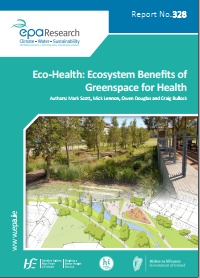
Research 328: Eco-Health: Ecosystem Benefits of Greenspace for Health
Authors: Mark Scott, Mick Lennon, Owen Douglas and Craig Bullock, July 2020
Year: 2020
This project advances the perspective that accessible and well-designed green spaces are essential infrastructure that is fundamental to the health and well-being of thriving and inclusive communities. There is a scientific consensus that green space provides multiple benefits for enhancing health and well-being, and these benefits provided by green space are increasingly recognised in policy at international, national and local levels.

Research 318: Source Apportionment of Particulate Matter in Urban and Rural Residential Areas of Ireland (SAPPHIRE)
In this research project, the contribution of residential solid fuel burning to ambient levels of wintertime PM2.5 was determined in the towns of Killarney, Enniscorthy and Birr. The results show that the burning of peat, coal and wood for home heating is by far the largest source of PM2.5 air pollution in these locations., June 2020
Year: 2020
In this research project, the contribution of residential solid fuel burning to ambient levels of wintertime PM2.5 was determined in the towns of Killarney, Enniscorthy and Birr. The results show that the burning of peat, coal and wood for home heating is by far the largest source of PM2.5 air pollution in these locations.
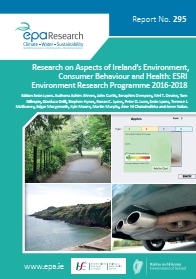
Research 295: Research on Aspects of Ireland’s Environment, Consumer Behaviour and Health: ESRI Environment Research Programme 2016–2018
Authors: Achim Ahrens, John Curtis, Seraphim Dempsey, Mel T. Devine, Tom Gillespie, Gianluca Grilli, Stephen Hynes, Ronan C. Lyons, Peter D. Lunn, Seán Lyons, Terence J. McElvaney, Edgar Morgenroth, Kyle Moore, Martin Murphy, Áine Ní Choisdealbha and Anne Nolan. Editor: Seán Lyons, October 2019
Year: 2019
The Economic and Social Research Institute (ESRI) Environment Research Programme 2016-2018 brought together a diverse set of research topics in which the environment interacts with economic and social processes. Detailed in this report are findings from 7 projects which were undertaken as part of the wider Programme.
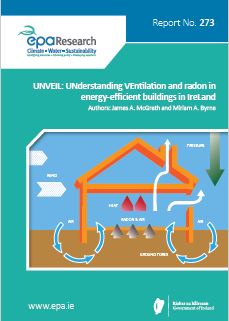
Research 273: UNVEIL: Understanding Ventilation and radon in energy-efficient buildings in Ireland
Authors: James A. McGrath and Miriam A. Byrne , April 2019
Year: 2019
In Ireland, radon gas is considered the greatest source of radiation exposure to the general population, accounting for just over 55% of the average radiation dose and is recognised as the second leading cause of lung cancer after tobacco smoke. Each year in Ireland, exposure to radon is linked to approximately 250 cases of lung cancer.
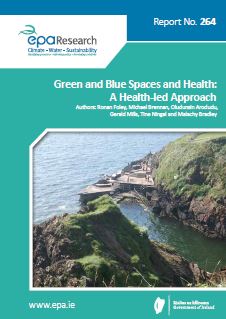
Research 264: Green and Blue Spaces and Health: A Health-led Approach
Authors: Ronan Foley, Michael Brennan, Oludunsin Arodudu, Gerald Mills, Tine Ningal and Malachy Bradley., November 2018
Year: 2018
This research was based on a 12-month desk study that modelled, for identified sample sites, the relationships between health indicators and the availability of green and blue infrastructure (GBI). It provided a route to identify measurable effects and results from a cross-sectional and area-based study.
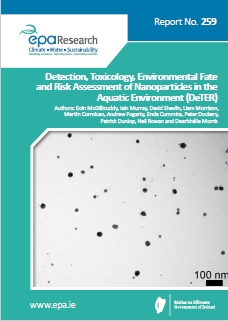
Research 259: Detection, Toxicology, Environmental Fate and Risk Assessment of Nanoparticles in the Aquatic Environment (DeTER)
Authors: Eoin McGillicuddy, Iain Murray, David Shevlin, Liam Morrison, Martin Cormican, Andrew Fogarty, Enda Cummins, Peter Dockery, Patrick Dunlop, Neil Rowan and Dearbháile Morris, September 2018
Year: 2018
Nanotechnology is an emerging technology that has the potential to impact on all aspects of life and the economy and is expected to form the basis of several technological innovations and advances in the 21st century.
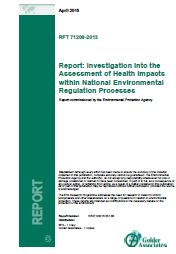
Investigation into the Assessment of Health Impacts within National Environmental Regulation Processes
Report commissioned by the Environmental Protection Agency, March 2017
Year: 2017
In 2013, the EPA commissioned Golder Associates to undertake a study into how human health impacts are dealt with throughout the European Union (EU) by environmental regulators with an emphasis on the role of health impact assessment (HIA) at the planning / environment interface.
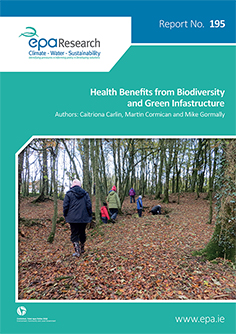
Research 195: Health Benefits from Biodiversity and Green Infastructure
Authors: Caitriona Carlin, Martin Cormican and Mike Gormally, December 2016
Year: 2016
This project reviewed (1) evidence of wellbeing and health benefits from biodiversity, (2) views of health benefits from nature held by people who make decisions regarding green space and (3) practices to engage the public with the natural environment as a sustainable health strategy, to inform policymakers and practitioners of the health benefits from the natural environment and to recommend implementation strategies in Ireland